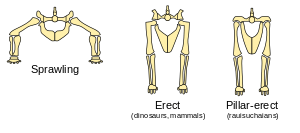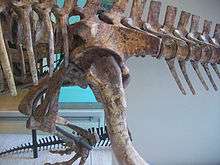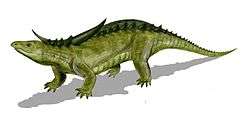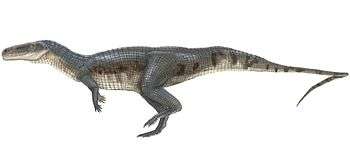Rauisuchia
| "Rauisuchians" Temporal range: Triassic, 249–200 Ma Descendant taxon Crocodylomorpha survives to present. | |
|---|---|
 | |
| Batrachotomus | |
| Scientific classification | |
| Kingdom: | Animalia |
| Phylum: | Chordata |
| Class: | Reptilia |
| Clade: | Suchia |
| Informal group: | †Rauisuchia Huene, 1942 |
| Subgroups | |
"Rauisuchia" is a group of mostly large (often 4 to 6 metres (13 to 20 ft)) Triassic archosaurs. It belongs to a larger clade called Pseudosuchia. "Rauisuchia" is currently considered an evolutionary grade, or even a wastebin taxon. It includes most pseudosuchians that lived during the Triassic Period. Since crocodylomorphs likely originated from an ancestor that would have been a rauisuchian, Rauisuchia in its traditional sense is considered paraphyletic as it excludes crocodylomorphs.[1] To designate it as an informal group in scientific literature, the name in its traditional sense is often enclosed in quotation marks.



Rauisuchians had an erect gait with their legs oriented beneath the body rather than sprawling outward. This type of gait is also seen in dinosaurs, but evolved independently in the two groups. In dinosaurs, the hip socket faces outward and the femur (thigh bone) connects to the side of the hip; while in rauisuchians, the hip socket faces downward to form a shelf of bone under which the femur connects.[2][3] This has been referred to as the pillar-erect posture.[4]
Rauisuchians lived throughout most of the Triassic. Along with many other large archosaurs, the group died out in the Triassic-Jurassic extinction event. After their extinction, theropod dinosaurs were able to emerge as the sole large terrestrial predators. The footprints of meat-eating dinosaurs suddenly increase in size at the start of the Jurassic, when rauisuchians are absent.[5]
Fossil record
Well-known rauisuchians include Ticinosuchus of the Middle Triassic of Europe (Switzerland and Northern Italy), Saurosuchus of the late Triassic (Late Carnian) of South America (Argentina), and Postosuchus of the late Triassic (Late Carnian to Early Norian) of North America (SW USA). One rauisuchian, Teratosaurus, was for a long time even considered an early theropod dinosaur,[6] but was later shown to be non-dinosaurian.[7][8]
History of classification
Rauisuchians were originally thought to be related to erythrosuchids,[9] but it is now known that they are crurotarsans.[10] Three families are generally recognised: Prestosuchidae, Rauisuchidae, and Poposauridae, as well as a number of forms (e.g. those from the Olenekian of Russia) that are too primitive and/or poorly known to fit in any of these groups. There has been considerable suggestion that the group as currently defined is paraphyletic, representing a number of related lineages independently evolving and filling the same ecological niche of medium to top terrestrial predator. For example, Parrish[11] and Juul[12] found poposaurid rauisuchians to be more closely related to Crocodilia than to prestosuchids. In a more recent study, Nesbitt[13] presented a different phylogeny with a monophyletic Rauisuchia. The group may even be something of a "wastebasket taxon". Determining exact phylogenetic relationships is difficult because of the scrappy nature of a lot of the material. However, recent discoveries and studies, such as those of Batrachotomus,[14] and restudies of other forms, such as Erpetosuchus,[15] are shedding light on the evolutionary relationships of this poorly known group.
Cladistics
Despite its inclusion as an informal grouping in numerous phylogenetic studies, "Rauisuchia" has never received a formal definition. Most analyses in the past decade have found "Rauisuchia" to be a paraphyletic grouping, including all studies with a large sample size. Those that found the possibility that it was a natural group produced only weak support for this hypothesis.[16] In his large 2011 analysis of archosaurian relationships, Nesbitt recommended that the term "Rauisuchia" be abandoned.[1]
In a study of the ctenosauriscid Arizonasaurus, paleontologist Sterling Nesbitt defined a clade of rauisuchians called "Group X."[17] This group includes Arizonasuchus, Lotosaurus (another ctenosauriscid), and Sillosuchus, Shuvosaurus, and Effigia (all poposaurids). One distinguishing feature of Group X is their lack of osteoderms, which are common among many other crurotarsans. Many more features are found in the pelvis, including fully fused sacral vertebrae and a long, thin crest on the illium called the supra-acetabular crest. Additionally, many members of Group X have smooth frontal and nasal bones, which make up the upper portion of the rostrum. In other rauisuchians and many other crurotarsans, this area has bumps and ridges.[18]
Nesbitt later erected another clade, "Group Y", in 2007.[18] Group Y falls within Group X to include Sillosuchus, Shuvosaurus, and Effigia. Group Y is diagnosed by the presence of four or more sacral vertebrae with fully fused neural arches, which is also seen in theropod dinosaurs (a case of evolutionary convergence). In addition, the cervical vertebrae that make up the neck are strongly amphicoelus, meaning that they are concave at both ends. The fourth trochanter, a ridge of bone on the femur for muscle attachment seen in nearly all archosaurs, is absent in Group Y.[18]
Although not placed within Group Y, Lotosaurus shares many similarities with members of the clade, foremost of which is edentulous, or toothless, jaws. Edentulism is also seen in Shuvosaurus and Effigia, which have beak-like jaws. Nesbitt suggested that the derived characters of Lotosaurus may indicate that it is a transitional form between basal members of Group X and members of Group Y.[18]
Below is the cladogram from Nesbitt (2007):[18]
| Rauisuchia |
| ||||||||||||||||||||||||||||||||||||
| |
In their phylogenetic study of archosaurs, Brusatte et al. (2010) found only weak support for Rauisuchia as a monophyletic grouping. As a result of their analysis, two clades were found to be within Rauisuchia, which they named Rauisuchoidea and Poposauroidea. Rauisuchoidea included Rauisuchidae and Prestosuchidae, as well as several basal taxa that were once assigned to the families, including Fasolasuchus and Ticinosuchus. Poposauroidea included poposaurids and ctenosauriscids, but the phylogeny had a large polytomy of genera in both groups that was difficult to resolve, which included Arizonasaurus, Poposaurus, and Sillosuchus. However, the characters linking these two groups were weak, and the question as to whether or not "Rauisuchia" forms a natural group remains unresolved.[16]
Below is the cladogram from Brusatte et al. (2010):[16]
| Rauisuchia |
| ||||||||||||||||||||||||||||||||||||||||||||||||||||||||||||||||||||||||||||||||||||||||||||||||||||||
| |
In a more thorough test of archosaurian relationships published in 2011 by Sterling Nesbitt, "rauisuchians" were found to be paraphyletic, with Poposauroidea at the base of the clade Paracrocodylomorpha, and the rest of the "rauisuchians" forming a grade within the clade Loricata. Nesbitt noted that no previous study of "rauisuchian" relationships had ever included a wide variety of supposed "rauisuchians" as well as a large number of non-"rauisuchian" taxa as controls.[1]
Notes
- 1 2 3 Nesbitt, S.J. (2011). "The early evolution of archosaurs: relationships and the origin of major clades" (PDF). Bulletin of the American Museum of Natural History. 352: 1–292. doi:10.1206/352.1.
- ↑ Bonaparte, J. F. (1984). "Locomotion in rauisuchid thecodonts". Journal of Vertebrate Paleontology. 3 (4): 210–218. doi:10.1080/02724634.1984.10011976.
- ↑ Benton, M. J. (1984). "Rauisuchians and the success of dinosaurs". Nature. 310 (5973): 101. doi:10.1038/310101a0.
- ↑ Benton, M. J.; Clark, J. (1988). "Archosaur phylogeny and the relationships of the Crocodylia". In Benton, M.J. (ed.). The Phylogeny and Classification of the Tetrapods. 1. Amphibians, Reptiles, Birds. Systematics Association. 35A. Oxford: Clarendon Press. pp. 289–332.
- ↑ Olsen, P. E.; Kent, D. V.; Sues, H.-D.; Koeberl, C.; Huber, H.; Montanari, E. C.; Rainforth, A.; Fowell; S. J.; et al. (2002). "Ascent of Dinosaurs Linked to an Iridium Anomaly at the Triassic-Jurassic Boundary". Science. 296 (5571): 1305–1307. doi:10.1126/science.1065522. PMID 12016313.
- ↑ See for example Colbert, E.H., 1961, Dinosaurs: Their Discovery and Their World, Dutton, New York, 1961 p.67
- ↑ Galton, P. M. (1985). "The poposaurid thecodontian Teratosaurus suevicus von Meyer, plus referred specimens mostly based on prosauropod dinosaurs". Stuttgarter Beitrage zur Naturkunde B. 116: 1–29.
- ↑ Benton, M.J. (1986). "The late Triassic reptile Teratosaurus - a rauisuchian, not a dinosaur". Palaeontology. 29: 293–301.
- ↑ Sill, W. D. (1974). "The anatomy of Saurosuchus galilei and the relationships of the rauisuchid thecodonts". Bulletin of the Museum of Comparative Zoology. 146: 317–362. ISSN 0027-4100.
- ↑ Benton, M. J. (2004). Vertebrate Paleontology (3rd ed.). Oxford: Blackwell Science Ltd. ISBN 0-632-05637-1.
- ↑ Parrish, J. M. (1993). "Phylogeny of the Crocodylotarsi, with reference to archosaurian and crurotarsan monophyly". Journal of Vertebrate Paleontology. 13 (3): 287–308. doi:10.1080/02724634.1993.10011511.
- ↑ Juul, L. (1994). "The phylogeny of basal archosaurs". Palaeontologia Africana. 31: 1–38.
- ↑ Nesbitt, S. J. (2003). "Arizonasaurus and its implications for archosaur divergence". Proceedings of the Royal Society B. 270 (Suppl. 2): S234–S237. doi:10.1098/rsbl.2003.0066. ISSN 0962-8452. PMC 1809943
 . PMID 14667392.
. PMID 14667392. - ↑ Gower, D. J. (2002). "Braincase evolution in suchian archosaurs (Reptilia: Diapsida): evidence from the rauisuchian Batrachotomus kupferzellensis". Zoological Journal of the Linnean Society. 136 (1): 49–76. doi:10.1046/j.1096-3642.2002.00025.x.
- ↑ Benton, M. J.; Walker, A. D. (2002). "Erpetosuchus, a crocodile-like basal archosaur from the Late Triassic of Elgin, Scotland". Zoological Journal of the Linnean Society. 136 (1): 25–47. doi:10.1046/j.1096-3642.2002.00024.x. ISSN 0024-4082.
- 1 2 3 Brusatte, S. L.; Benton, M. J.; Desojo, J. B.; Langer, M. C. (2010). "The higher-level phylogeny of Archosauria (Tetrapoda: Diapsida)". Journal of Systematic Palaeontology. 8 (1): 3–47. doi:10.1080/14772010903537732.
- ↑ Nesbitt, S.J. (2005). "Osteology of the Middle Triassic pseudosuchian archosaur Arizonasaurus babbitti". Historical Biology. 17 (1): 19–47. doi:10.1080/08912960500476499.
- 1 2 3 4 5 Nesbitt, S.J. (2007). "The anatomy of Effigia okeeffeae (Archosauria, Suchia), theropod-like convergence, and the distribution of related taxa" (PDF). Bulletin of the American Museum of Natural History. 302: 1–84. doi:10.1206/0003-0090(2007)302[1:TAOEOA]2.0.CO;2. ISSN 0003-0090.
References
- Carroll, R. L. (1988). Vertebrate Paleontology and Evolution. New York: WH Freeman & Co. ISBN 0-7167-1822-7.
- "Archosauromorpha: Rauisuchiformes". Palaeos. Retrieved January 2010. Check date values in:
|access-date=(help) - Poling, Jeff; Creisler, Ben (December 1996). "Rauisuchia Translation and Pronunciation Guide". Dinosauria On-Line. Retrieved January 2010. Check date values in:
|access-date=(help)



